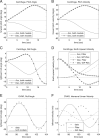Differences between perception and eye movements during complex motions
- PMID: 21846952
- PMCID: PMC3668572
- DOI: 10.3233/VES-2011-0416
Differences between perception and eye movements during complex motions
Abstract
During passive whole-body motion in the dark, the motion perceived by subjects may or may not be veridical. Either way, reflexive eye movements are typically compensatory for the perceived motion. However, studies are discovering that for certain motions, the perceived motion and eye movements are incompatible. The incompatibility has not been explained by basic differences in gain or time constants of decay. This paper uses three-dimensional modeling to investigate gondola centrifugation (with a tilting carriage) and off-vertical axis rotation. The first goal was to determine whether known differences between perceived motions and eye movements are true differences when all three-dimensional combinations of angular and linear components are considered. The second goal was to identify the likely areas of processing in which perceived motions match or differ from eye movements, whether in angular components, linear components and/or dynamics. The results were that perceived motions are more compatible with eye movements in three dimensions than the one-dimensional components indicate, and that they differ more in their linear than their angular components. In addition, while eye movements are consistent with linear filtering processes, perceived motion has dynamics that cannot be explained by basic differences in time constants, filtering, or standard GIF-resolution processes.
Figures





Similar articles
-
Baselines for three-dimensional perception of combined linear and angular self-motion with changing rotational axis.J Vestib Res. 2000;10(4-5):163-78. J Vestib Res. 2000. PMID: 11354430
-
Tilt and translation motion perception during off-vertical axis rotation.Exp Brain Res. 2007 Sep;182(3):365-77. doi: 10.1007/s00221-007-0994-0. Epub 2007 Jun 13. Exp Brain Res. 2007. PMID: 17565488
-
Eye movements evoked by proprioceptive stimulation along the body axis in humans.Exp Brain Res. 1998 Jun;120(4):450-60. doi: 10.1007/s002210050418. Exp Brain Res. 1998. PMID: 9655230
-
Alteration of eye movements and motion perception in microgravity.Brain Res Brain Res Rev. 1998 Nov;28(1-2):161-72. doi: 10.1016/s0165-0173(98)00036-8. Brain Res Brain Res Rev. 1998. PMID: 9795198 Review.
-
From 1D to 2D via 3D: dynamics of surface motion segmentation for ocular tracking in primates.J Physiol Paris. 2004 Jan-Jun;98(1-3):35-52. doi: 10.1016/j.jphysparis.2004.03.017. J Physiol Paris. 2004. PMID: 15477021 Review.
Cited by
-
Head-Eye Vestibular Motion Therapy Affects the Mental and Physical Health of Severe Chronic Postconcussion Patients.Front Neurol. 2017 Aug 22;8:414. doi: 10.3389/fneur.2017.00414. eCollection 2017. Front Neurol. 2017. PMID: 28878731 Free PMC article.
-
Human perceptual overestimation of whole body roll tilt in hypergravity.J Neurophysiol. 2015 Apr 1;113(7):2062-77. doi: 10.1152/jn.00095.2014. Epub 2014 Dec 24. J Neurophysiol. 2015. PMID: 25540216 Free PMC article.
-
Modeling human perception of orientation in altered gravity.Front Syst Neurosci. 2015 May 5;9:68. doi: 10.3389/fnsys.2015.00068. eCollection 2015. Front Syst Neurosci. 2015. PMID: 25999822 Free PMC article.
-
Vestibular implantation and longitudinal electrical stimulation of the semicircular canal afferents in human subjects.J Neurophysiol. 2015 Jun 1;113(10):3866-92. doi: 10.1152/jn.00171.2013. Epub 2015 Feb 4. J Neurophysiol. 2015. PMID: 25652917 Free PMC article.
References
-
- Angelaki DE, Shaikh AG, Green AM, Dickman JD. Neurons compute internal models of the physical laws of motion. Nature. 2004;430:560–564. - PubMed
-
- Bles W, de Graaf B. Postural consequences of long duration centrifugation. Journal of Vestibular Research. 1993;3:87–95. - PubMed
-
- Bockisch CJ, Straumann D, Haslwanter T. Eye movements during multiaxis whole-body rotations. Journal of Neurophysiology. 2003;89:355–366. - PubMed
-
- Borah J, Young LR, Curry RE. Optimal estimator model for human spatial orientation. Annals of the New York Academy of Sciences. 1988;545:51–73. - PubMed
-
- Boring EG, Langfeld HS, Weld HP. Foundations of Psychology. John Wiley and Sons, Inc.; New York: 1948.
Publication types
MeSH terms
Grants and funding
LinkOut - more resources
Full Text Sources

